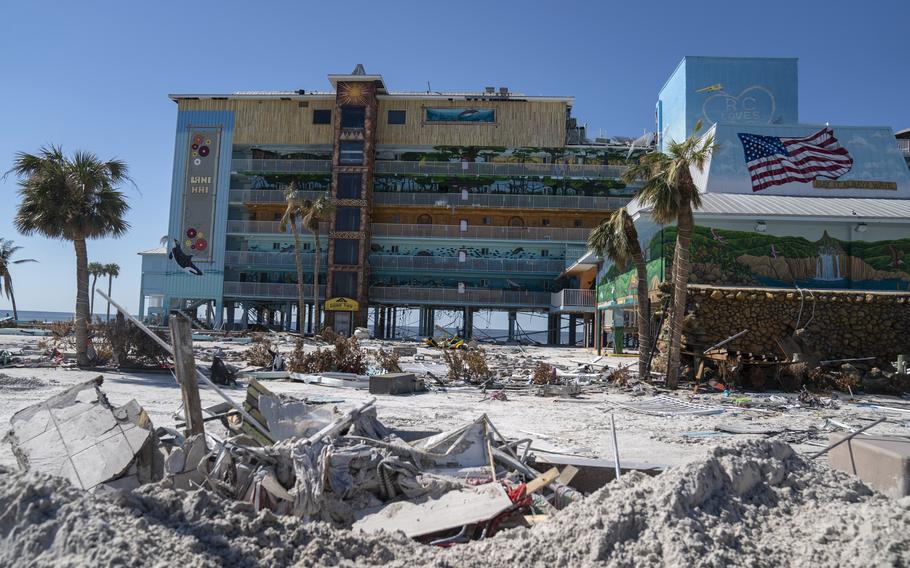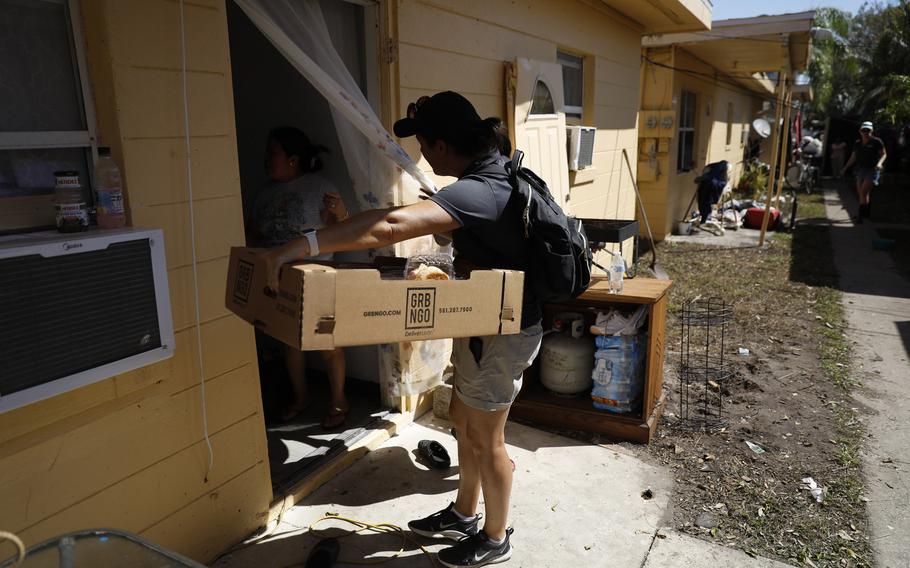
The Lani Kai Hotel stands surrounded by debris on Oct. 7, 2022 in Fort Myers Beach, Fla. Hurricane Ian’s storm surge caused catastrophic damage on the barrier island. (Michael Robinson Chavez)
On Visit Florida's website, click on the "Southwest" region of the map and a link sweeps you off to Barefoot Beach in Naples. In the photo, beach goers lounge on the white sand, a gentle breeze barely ruffling the beach umbrellas. Wavelets ripple across the Gulf of Mexico. You want to be there, but you will have to wait -- weeks, maybe months, depending on recovery efforts following Hurricane Ian and your own ethical calculations.
A responsible return of tourism "depends on the location and the level of devastation," said Stephanie Murphy, vice president of preparedness, resiliency and emergency management at Tidal Basin, a disaster preparedness and recovery consulting firm. "Everyone's own moral code also has to come into play."
No two natural disasters are alike, and no recovery timeline is the same. Some destinations will quickly hang the "Welcome Back" sign; others will keep it in storage for an indeterminate time.
If you are conflicted by the idea of vacationing in a destination that has experienced staggering loss, here is some balm for your soul: As soon as the infrastructure can handle tourists, your visit will support the local economy, fill the tax coffers and, most important, reassure locals that they are not alone.
"It's reasonable to feel uncomfortable, but it's not insensitive," says Josh Dozor, a general manager for the Americas at risk assessment firm International SOS. "The people want to return to normal, and tourism is part of that normalcy. Seeing tourists is a sign that everything is going to be okay."
Puerto Rico tourism bounces back
Puerto Rico, which was pummeled by Hurricane Fiona on Sept. 18, rebounded quickly. Brad Dean, chief executive of tourism marketing organization Discover Puerto Rico, called the storm a "temporary disruption."
With the exception of the southwest region of the island, the majority of hotels, attractions and beaches have reopened, if they had closed at all. Five days after Fiona made landfall, Journey performed to 18,000 concert goers in San Juan. This week, El Yunque National Forest swung open its gates, though a few of its damaged trails remain off-limits.
"Fiona caused a setback but not a reset," Dean said. "Visitors started returning within two weeks of landfall."
Southwest Florida still in recovery mode
More than a thousand miles to the north, communities in southwestern Florida are still assessing the devastation brought by Hurricane Ian, which Puerto Rico knows all too well after Hurricane Maria slammed into the island five years ago.
"We ask visitors to put travel plans on hold for the time being," said Tamara Pigott, executive director of Lee County Visitor & Convention Bureau, which includes some of the hardest-hit towns, such as Fort Myers Beach and Sanibel.
DT Minich, president and chief executive of Experience Kissimmee, is no stranger to disasters: He was working in tourism when hurricanes Charley and Wilma (2004 and 2005, respectively) and the Deepwater Horizon oil spill (2010) roiled Florida. He said local governments will not sugarcoat the situation and invite tourists back prematurely.
"They're trying to clean up and build back up," he said of his neighbors about 150 miles to the southwest. "They don't want or need visitors right now." He added that the Kissimmee region will be completely operational this weekend, when Wild Florida and Gatorland will fully reopen after suffering flooding.

Volunteers and staff members with Better Together, a nonprofit organization based in Naples, Fla., deliver food and toiletries for families in the Harlem Heights neighborhood in Fort Myers on Oct. 4. (Octavio Jones/For The Washington Post)
How to know if it's OK to go
If government or tourism officials ask tourists to postpone their trips, travelers should heed their plea. But the question of whether to visit, and when, is murkier without such a clear directive. Intel and soul-searching can lead you to the right answer.
"When is it more ethical to not go and when is it responsible to go?" said Claire Bennett, co-founder of Learning Service, a voluntourism company, who lived in Nepal during the 2015 earthquake. "The rawness and trauma of natural disasters can't be overlooked. Before you go, you have to be sure of your purpose." Are you going there to volunteer or to sight-see? Are your interests appropriate in the current climate?
Recovery and restoration operations unfold in stages. Dozor said leisure travelers should avoid places during the early response and immediate recovery phases, when critical services and utilities are still down. A "stabilized" environment, he said, "is achieved when essential lifelines are operational, but not yet fully restored or repaired."
Obviously, travelers can't visit if airports or major thoroughfares are closed and critical bridges are down, such as Sanibel's causeway. Even if commercial flights have resumed and cars are back on the road, Dozor advises travelers to hold off on visiting a destination that is grappling with widespread power outages, compromised road accessibility, inoperable cell towers, boiling water advisories or beleaguered hospitals.
"These are good indicators to not go," he said.
If you visit too soon
One of the consequences of travelers returning too soon is that they may place undo pressure on a fragile or fractured infrastructure and stretch already-thin resources.
Lodgings often house survivors, emergency workers and contractors, so room availability could be tight. Short-term rentals might also be scarce: Last week, Airbnb announced it will provide vouchers to displaced residents of Florida's Lee and Charlotte counties. Downed power lines and trees can block transportation routes, affecting food and fuel supplies.
"A general rule would be to wait until your presence is more of a benefit to the affected community than a hindrance," said Tim Dean, senior philosopher with the Ethics Centre in Sydney. "That means being mindful of the community's needs and challenges and being sure not to consume resources like food, accommodation or power that the community or essential workers might need during recovery."
For the latest recovery updates, check the websites or social media accounts of local governments, tourism offices and emergency management departments. Also contact your hotel for the state of the accommodations. (Try emailing if the property's landline is not working.) Many amenities might not be available: The pool might be filled with debris, the fitness center plunged in darkness, the snack shelves in the lobby's mini-market bare.
"You need to manage your expectations," Dozor said.
What to expect when you arrive
Dozor encourages travelers to prepare for disaster-related challenges. For instance, renting a car could be difficult if the storm has wiped out inventory or relief organizations have snapped rental vehicles.
Bring a substantial amount of cash in case ATMs are short on bills and credit card machines are down because of power outages. Print out or pick up maps in the event that your navigational apps can't connect. Dozor also advises against driving beyond a round-trip tank of gas, in the off-chance you can't find an open gas station.
When you interact with locals, be sensitive to what they have gone through, and are going through. Shower them with kindness and empathy. "The staff might be tired, or new," Murphy said. "Be more patient than normal."
Recovery experts urge travelers to stick to the commercial areas, which often bounce back faster than residential neighborhoods, and leave the most devastated sections alone to heal. "Don't do disaster tourism. Don't try to find the impacted areas," Murphy said. "Be respectful and go to the touristy areas."
How to help on the ground
For travelers eager to volunteer, Murphy warns against showing up at a nonprofit or charity unannounced. Your sudden appearance could upset the flow and order. Also, do not drop off items that are not on an organization's wish list. "It overwhelms the system," Murphy said.
Katie Wilkes, a spokeswoman for the American Red Cross, said a monetary donation is preferable to household goods and other products, which, she said, "strip valuable resources like time, money and energy from the response operation."
To assist the right way, before you depart, connect with an established local or national nonprofit or nongovernmental organization, such as the American Red Cross, United Way, World Central Kitchen or Crisis Cleanup, an online platform that manages recovery events. You can also reach out to humane societies and animal shelters, which will have an influx of dogs and cats that need food, blankets and comfort.
And, of course, spending money at local establishments can boost the destination's economy and spirits.